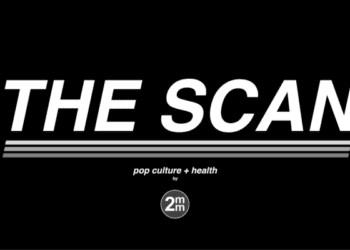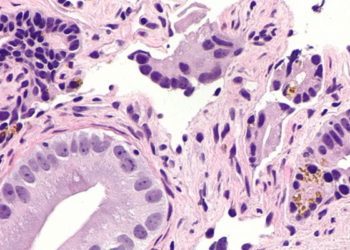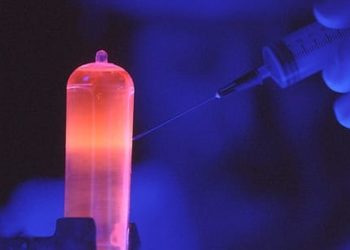Preoperative MRI improves surgical outcomes in robotic prostatectomy
1. Among prostate cancer patients treated with robot-assisted radical prostatectomy, the use of preoperative prostate magnetic resonance (MR) imaging significantly reduced the risk of postoperative positive surgical margins.
2. Preoperative MR imaging showed a high negative predictive value for the presence of positive surgical margins.
Evidence Rating Level: 2 (Good)
Study Rundown: Disease-free recovery following radical prostatectomy for prostate cancer is in large part defined by the absence of tumor cells at the surgical margins. However, this must be obtained while paying careful attention to the preservation of nearby neurovascular bundles, damage to which can result in post-operative incontinence and impotence. Robot-assisted surgical procedures are increasingly employed to allow for the level of surgical precision necessary to maintain both a negative surgical margin and protect those critical structures and avoid complications. In order to spare as much tissue as possible, pathologic analysis of intraoperative frozen sections (IFS) has been additionally used; however, without a guided approach, this technique has suffered from reports of high costs and low sensitivity and specificity.
The current study examined the use of preoperative multiparametric MR imaging to anatomically direct IFS analysis to areas of high risk of prostatic capsular or neurovascular involvement prior to robot-assisted radical prostatectomy (RARP). A cohort of patients underwent MR-image directed IFS analysis, while an age- and tumor-matched control group received standard RARP. Results suggested that patients who underwent MR-guided IFS had a significantly lower rate of positive surgical margins on final pathologic analysis as compared to patients who did not undergo imaging or IFS analysis. Among patients with positive imaging findings, secondary resections were performed contributing to final margin clearance. Preoperative MR imaging showed a perfect negative predictive value for the presence of positive surgical margins, allowing for a complete avoidance of IFS in selected cases. The study was limited by the lack of an IFS-only control group, and by a lack of outcome data regarding post-operative sequelae. Future randomized, controlled trials are warranted to examine the specific effects of imaging on surgical margins and its effects on post-operative morbidity and mortality.
Click to the study in Radiology
Relevant Reading: Role of frozen section analysis of surgical margins during robot-assisted laparoscopic radical prostatectomy: a 2608-case experience (Human Pathology)
In-Depth [prospective case-control]: This study examined a total of 268 patients undergoing RARP for stage I or stage II prostate cancer with an average age of 61.2 years, split into two age-, PSA-, and stage-matched groups. One group underwent MR-guided IFS analysis while the other received surgery alone. Positive post-operative surgical margins were found in 10 of 134 (7.5%) patients who received MR-guided IFS analysis while the remainder had negative surgical margins. Eighteen of these 134 patients had imaging evidence of tumor involving prostatic capsule, and 13 of these 18 required secondary resection to achieve margin negativity. Capsular involvement was not detected on imaging in 31 patients, allowing these patients to forego IFS analysis, all of whom had negative margins, resulting in a negative predictive value for the presence of positive surgical margins of 100% when employing multiparametric MR imaging. However, in the 103 patients in whom imaging detected capsular involvement, 10 remained tumor positive post-operatively, resulting in a positive predictive value of 9.7%. When comparing the image-guided IFA analysis group to the surgery only group, positive surgical margins were found in 7.5% versus 18.7% (P = 0.01) of patients, respectively. This resulted in one-seventh the risk of postoperative positive surgical margins in patients who underwent imaging and IFA analysis versus those who did not.
More from this author: Many lung cancers visible on prior imaging studies, Perfusion imaging may be useful for selecting stroke patients for thrombolysis, Image-guided biopsy of indeterminate ovarian masses appears safe and effective.
Image: PD
©2012-2014 2minutemedicine.com. All rights reserved. No works may be reproduced without expressed written consent from 2minutemedicine.com. Disclaimer: We present factual information directly from peer reviewed medical journals. No post should be construed as medical advice and is not intended as such by the authors, editors, staff or by 2minutemedicine.com. PLEASE SEE A HEALTHCARE PROVIDER IN YOUR AREA IF YOU SEEK MEDICAL ADVICE OF ANY SORT.

![2 Minute Medicine: Pharma Roundup: Price Hikes, Breakthrough Approvals, Legal Showdowns, Biotech Expansion, and Europe’s Pricing Debate [May 12nd, 2025]](https://www.2minutemedicine.com/wp-content/uploads/2025/05/ChatGPT-Image-May-12-2025-at-10_22_23-AM-350x250.png)





